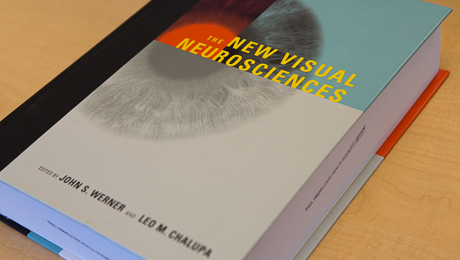By Danny Freedman
Light streams in and is first focused, then filtered through a lens and collected by more than a hundred million cones and rods, which pack it up and ship it to central processing along a million high-speed cables.
That’s the first instant of seeing these words. Then there’s the recognition of shapes and patterns, and the perception of color and brightness and texture and meaning.
“And it’s all effortless. You don’t even think of it,” said Leo Chalupa, a neuroscientist and GW’s vice president for research. “Even movement or speech, you have to give some thought, maybe just a tiny bit—what are you going to say, how are you going to say it—even if you’re not aware of it. But vision is effortless.”
Dr. Chalupa, who also is a professor in the School of Medicine and Health Sciences’ Department of Pharmacology and Physiology, has spent most of his career exploring that process in the lab, and he continues the pursuit in a new book, The New Visual Neurosciences, published in October by MIT Press.
The book, which Dr. Chalupa co-edited with John S. Werner, a neuroscientist at University of California, Davis, is a 1,600-page compendium on the state of the science, penned by some of the top scholars in the field. It sets out to map a research landscape that is rapidly expanding from all sides, covering not just new ideas on how the visual system works but also how it develops in fetuses and how it evolved.
Geared toward academic readers and scientists, the book is a follow up to a two-volume set on the same topic edited by Dr. Chalupa and Dr. Werner and published in 2004.
“We could not have anticipated that, in only one decade, many of these areas would advance so fast and so far as to require much more than an update,” they write in the book.
That means many of the chapters are entirely new, bringing into the mix new or increasingly relevant topics in the field, like optogenetics, the engineering of brain cells that can be controlled by light, and translational research, a field that bridges basic science and medicine. Another topic, invertebrate vision, has been historically fundamental to understanding the basics of visual processing and, in including it, the editors acknowledge that still today, invertebrates “continue to fascinate and challenge.”
The rapid advance of visual neuroscience has been fueled by the factors driving many other sciences, Dr. Chalupa said, including the increasingly multidisciplinary nature of studies and the availability of technology and techniques “to do things that were unheard of not that long ago.”
For instance, studies of individual brain cells that once had to be conducted one cell at a time can now be done by the thousand. “It’s not just that you’re getting more data, but you’re getting a different kind of data,” he said. “... So you’re able to answer questions about the underlying circuitry, not just one cell.”
Those advances have helped illuminate the connections between the dozens of subtopics within the field, Dr. Chalupa said, and have only added to the wonderment of natural visual systems—which remain unrivaled by the best efforts of mankind.
“You can take a picture of something and a smartphone will tell you that it’s the Eiffel Tower without any kind of problem,” he said. “But take a pencil and turn it a different direction, they won’t recognize it as the same thing.”
“These very elaborate calculations that no computer can do today,” he said, “are done by an infant.”


